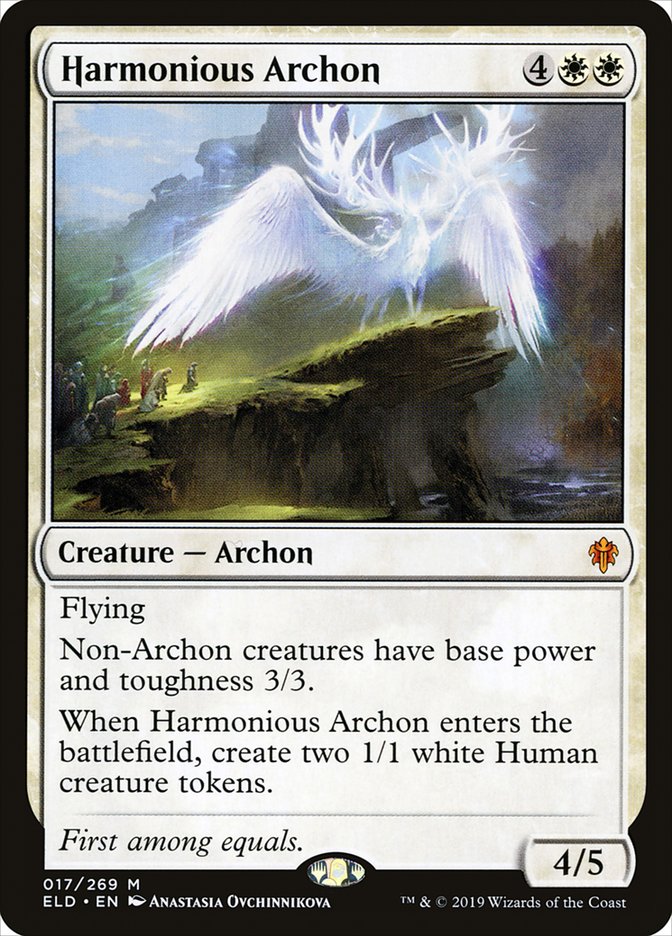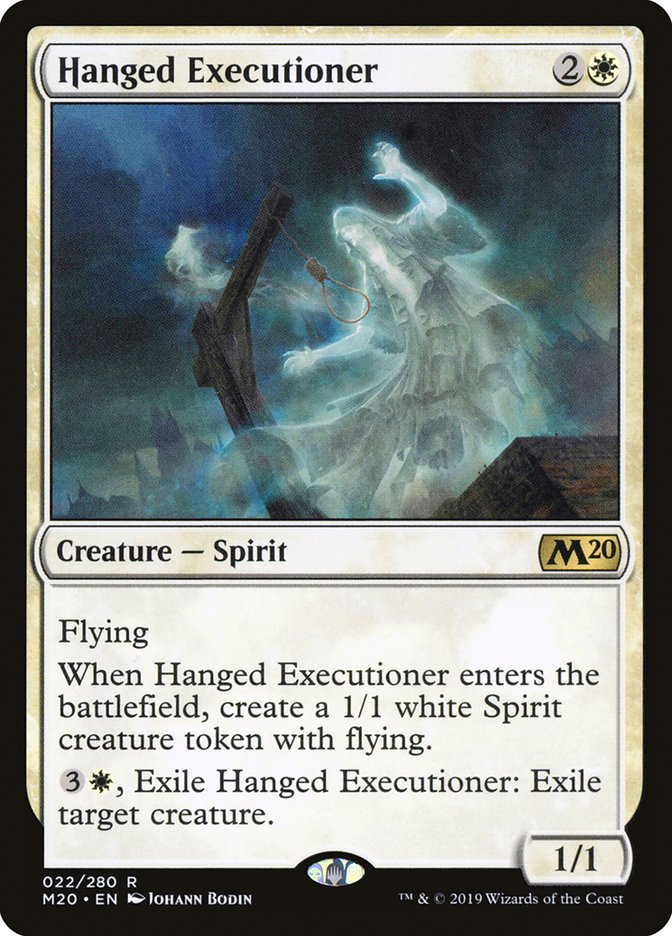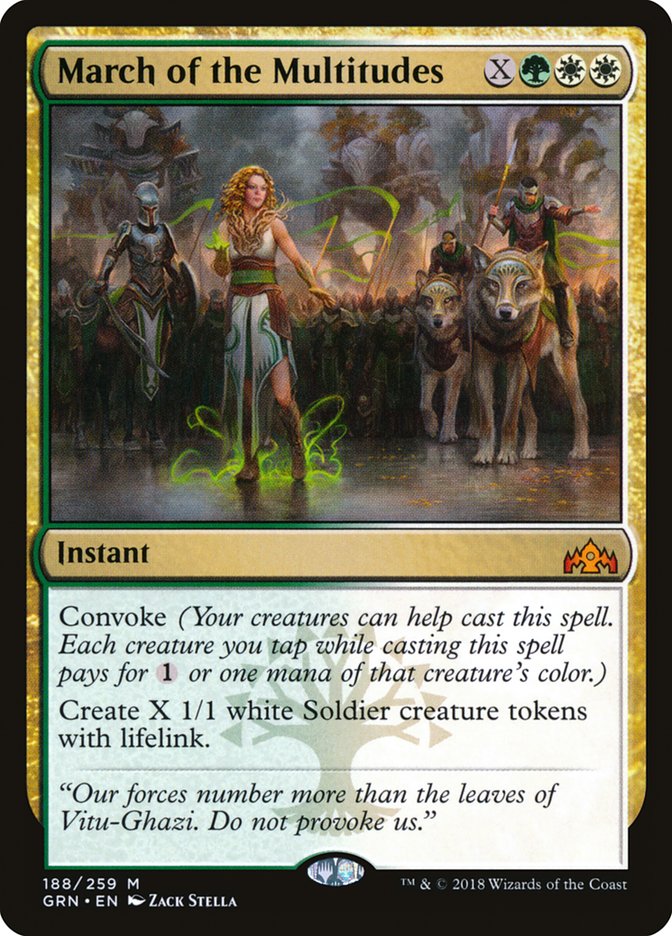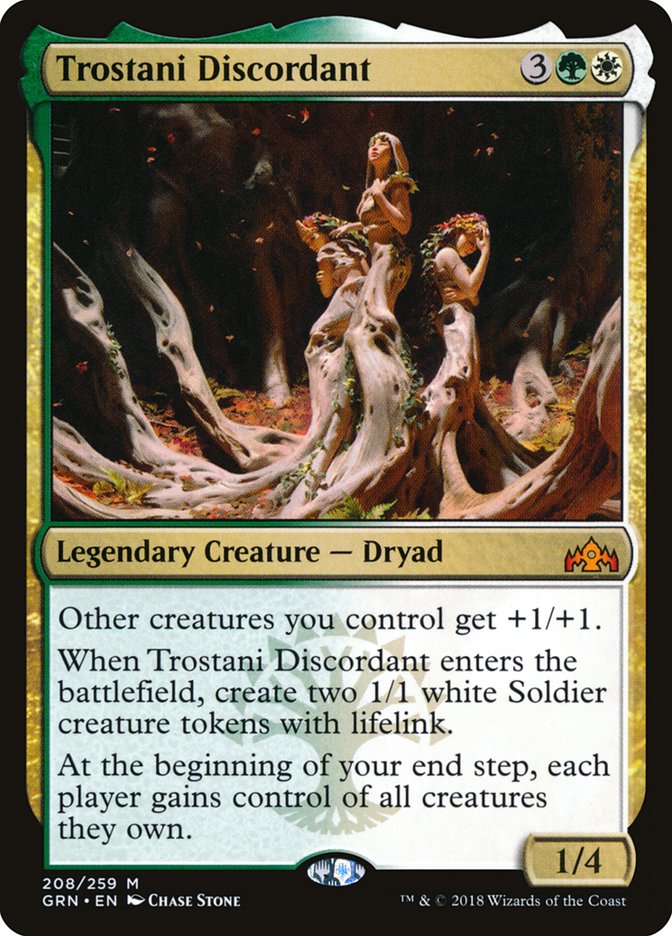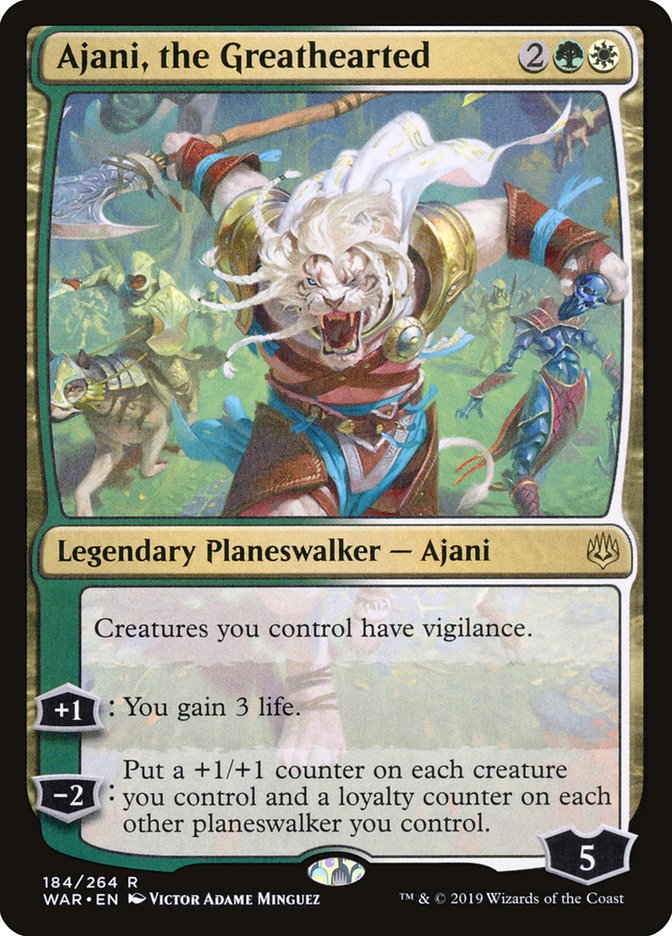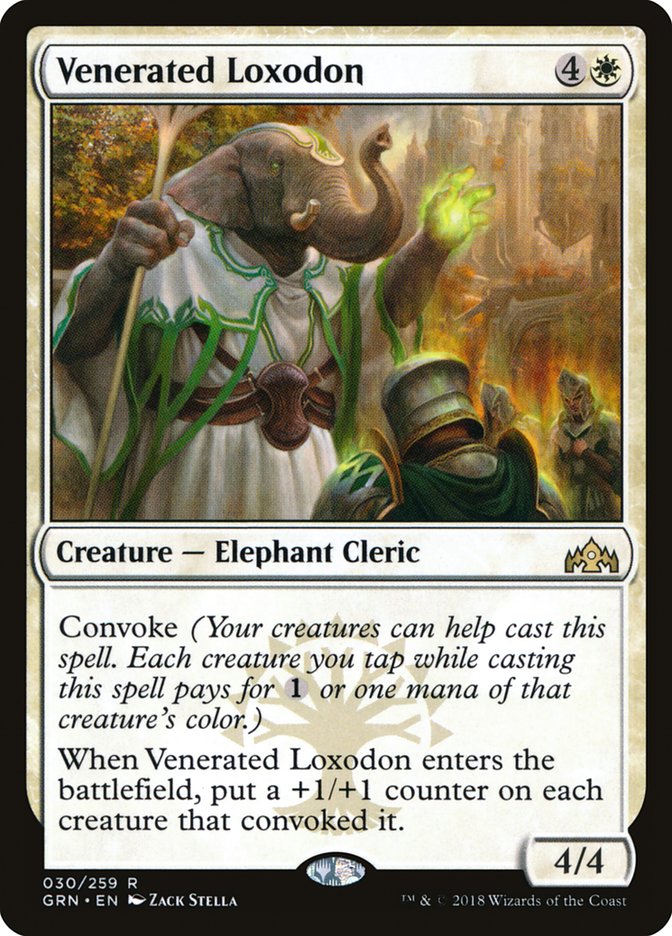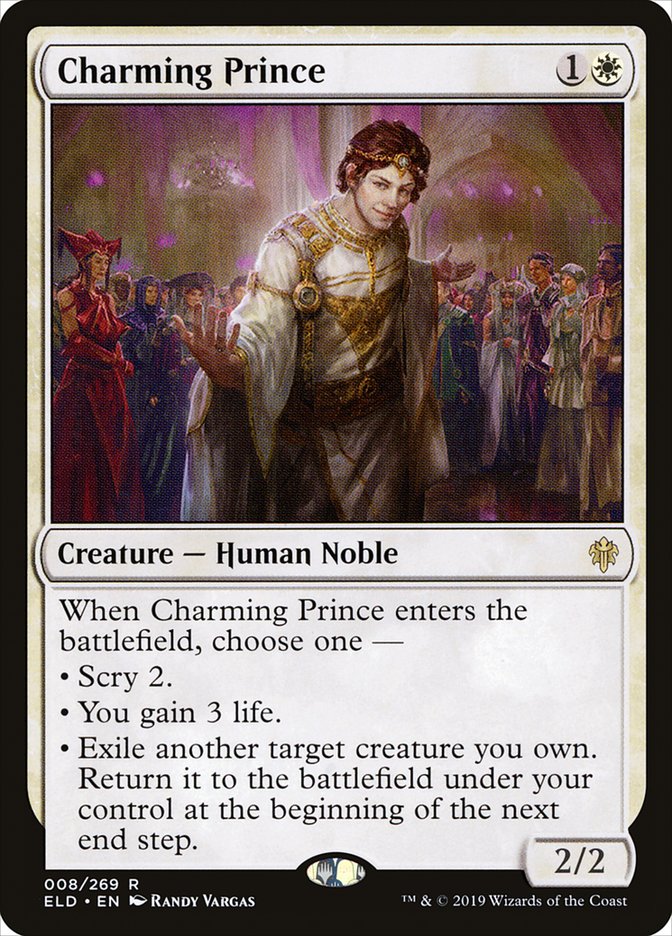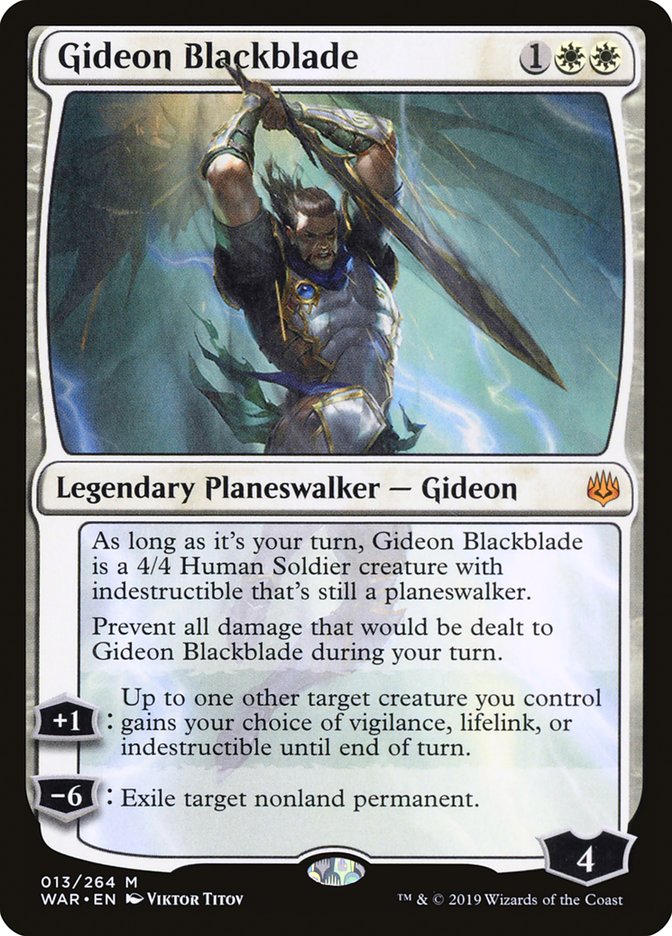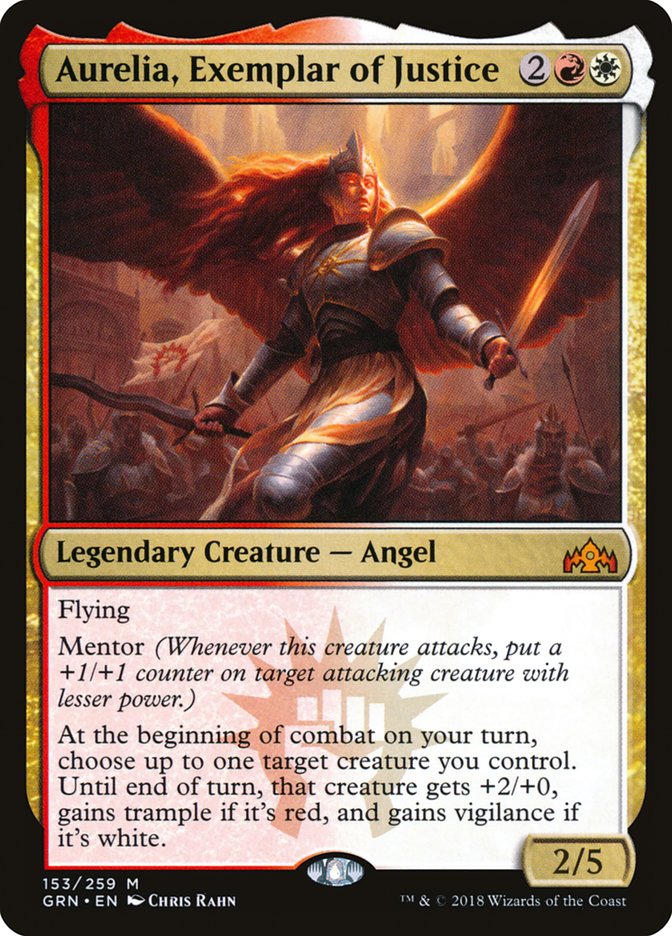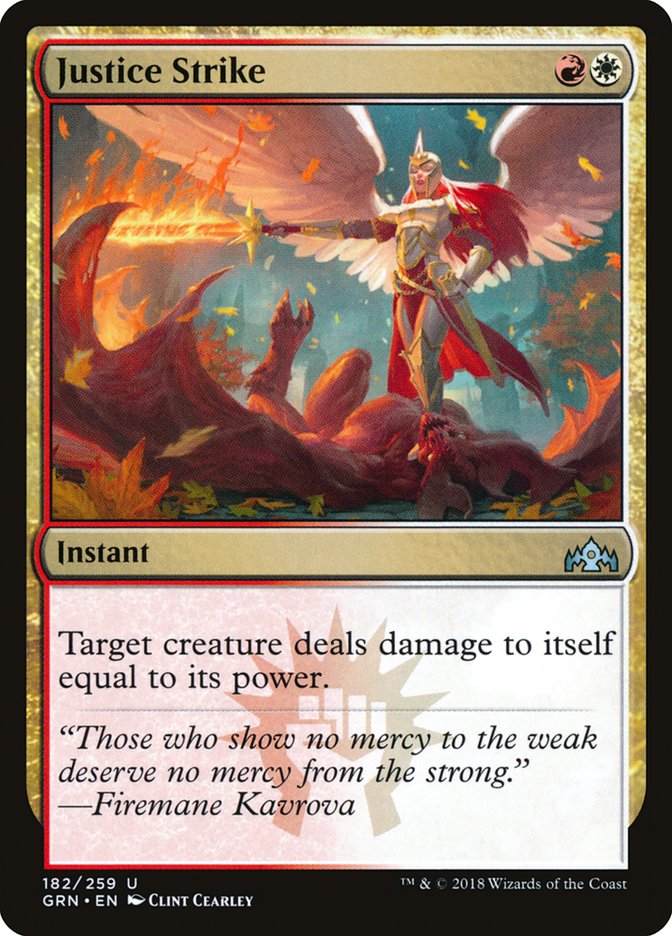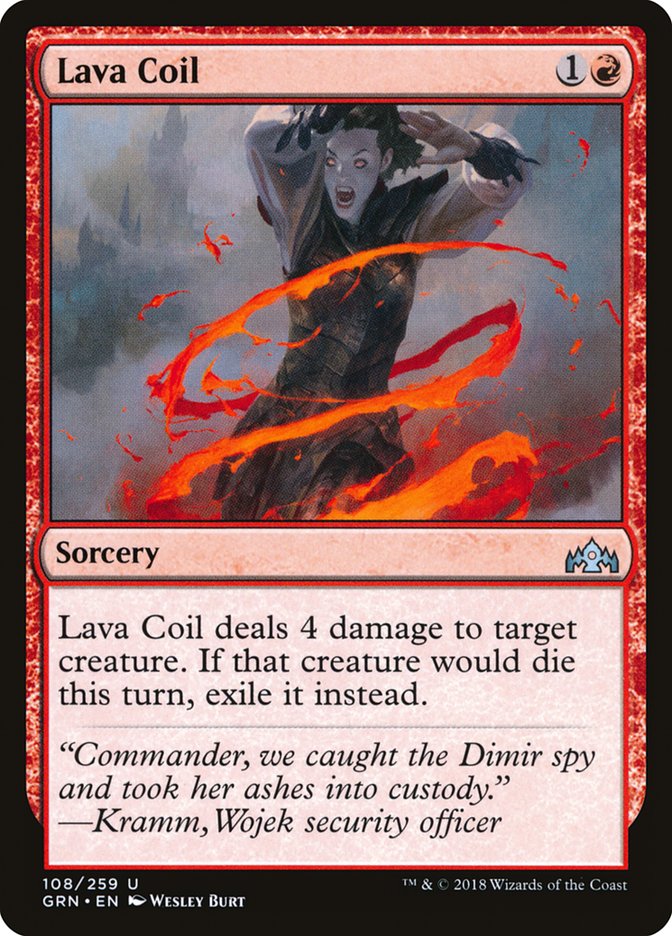It’s pretty clear over Standard’s history that there’s lots of value in
cards that efficiently create multiple bodies. Spreading your power around
makes it harder for spot removal to efficiently clear the battlefield and
trying to stabilize with blockers leaves you in a tenuous spot, hoping that
your key blocker or two aren’t hit by opposing removal spells.
Of course, if those blockers stick around, all those extra bodies aren’t
much help. That’s why token makers that can also serve as standalone
threats have been particularly successful, like Cloudgoat Ranger that flies
over them or Huntmaster of the Fells that can transform into something
larger.
The recently previewed Harmonious Archon fits this mold and may be the most
powerful army-in-a-can to date.
On rate you’re getting ten power and eleven toughness for six mana, which
is expensive but a huge amount of power spread over three bodies, so the
card represents a significant threat against control decks and something
that can quickly stabilize the battlefield against aggressive decks. On a
clogged battlefield, the Archon itself is likely to be the largest creature
and with built-in evasion it will often clock the opponent in the air while
the ground is stalemated. When I’m investing six mana in a card, I want it
to be effective whether ahead or behind, and Harmonious Archon certainly
checks that box.
The raw stats are already impressive, but the most important part of the
card is the static ability. Resetting every non-Archon creature to a base
3/3 can have such a dramatic impact on the battlefield. Against big
creatures like Lovestruck Beast, this ability ensures that the Human tokens
created by Harmonious Archon will be able to trade effectively. There’s
some concern when playing against a go-wide aggro strategy that Archon can
pump opposing creatures but creating three bodies with one card should
ensure that you don’t get overrun.
Leaving behind some bodies when it dies is always a plus, but at six mana
you’d prefer not to lose the Archon to that many removal spells.
Fortunately, the 4/5 dodges most red removal, as well as the cheap removal
from other colors. It’s going to take a premium removal spell like
Murderous Rider or Conclave Tribunal to answer Archon, and using Tribunal
is a big risk.
So, I’m definitely interested in playing this card, and the next question
is how best to leverage it. With that static ability, we want to go wide
with cheap creatures, but to break the symmetry it’s going to be important
to overload on anthem effects. Adding +1/+1 counters is especially good
since Harmonious Archon affects the base power and toughness of each
non-Archon creature, so the counters ensure that all of your creatures
dominate your opponent’s.
We want tokens and anthems, so that means Selesnya:
Creatures (22)
- 3 Emmara, Soul of the Accord
- 4 Venerated Loxodon
- 4 Trostani Discordant
- 4 Hanged Executioner
- 4 Charming Prince
- 3 Harmonious Archon
Planeswalkers (1)
Lands (21)
- 7 Forest
- 10 Plains
- 4 Temple Garden
Spells (16)

Selesnya Tokens was a successful deck for much of the last year, and it
largely survives rotation since the core of the deck comes from Guilds of Ravnica. Losing History of Benalia is a blow, but Hanged
Executioner is a solid card, and it’s nice to have some more evasive
creatures to pair with the anthems so you can focus on clogging the ground
while clocking your opponent in the air. That evasion is especially nice
with Harmonious Archon, turning Hanged Executioner into six flying power
which will end the game quickly if the 4/5 isn’t immediately answered.
Hanged Executioner also adds some much-needed removal in a deck that
doesn’t have space for anything beyond Conclave Tribunal in the maindeck.
And lastly, creating two bodies immediately means that unlike History of
Benalia, Hanged Executioner enables the strong opening of Raise the
Alarm-Hanged Executioner+Conclave Tribunal.
Harmonious Archon acts as a double-anthem, taking the bevy of 1/1s this
deck creates and turning them into 3/3s. It’s an even better follow-up to
an end of turn March of the Multitudes than Flourish, which gives the deck
more redundancy for that one-two punch that often feels like a Splinter
Twin combo. With the poor mana for friendly color pairs, I expect the split
card to be cast as Flower most of the time, so that redundancy is
particularly important.
Of course, we need to break the symmetry of our double-anthem to ensure
Archon is effective on clogged battlefields, so I loaded the deck with even
more anthem effects than typical Selesnya decks, maxing out on Trostani
Discordant and including a singleton copy of Ajani, the Greathearted on top
of the Venerated Loxodons and Flowers. It’s hard to imagine Archon of
Justice’s seemingly symmetric ability not creating a completely lopsided
battlefield as you can easily turn all of your 3/3s into 4/4s or 5/5s.
But my favorite aspect of Harmonious Archon in this deck is the way it
functions as a standalone threat. When your opponent breaks up the
synergies with sweepers and other disruption, cards like March of the
Multitudes and Venerated Loxodon can look embarrassing, but even on an
empty battlefield, Harmonious Archon is a game-altering threat. It doesn’t
get better than finding a card that synergizes well with a deck but doesn’t
rely on those synergies to be effective.
Archon being a standalone threat also means your opponent is priced into
keeping in enough spot removal to check it, when that removal is rather
weak against the rest of the deck. It’s always good to force your opponents
into spots where they have to make tough decisions, and Harmonious Archon
essentially does that for free here.
There’s another important addition to the archetype from Throne of Eldraine, and one I expect to be best friends with
Harmonious Archon – Charmed Prince. In the early game, you can scry to set
up your draws and maximize your chances of curving out, and later on it may
just be a Grizzly Bear but there’s plenty of good targets for the flicker
mode. Archon of Justice and Trostani Discordant let you create two more
bodies while Hanged Executioner and Tolsimir, Friend to Wolves give you one
more. Knight of Autumn is another great target, either generating another
Disenchant or upgrading the 2/1 to a 4/3, thus turning Charmed Prince into
a two-mana threat that generates four power.
I favored Selesnya early in Guilds of Ravnica Standard because it
had obviously powerful cards and clear ways to build synergy. The same is
true now and with some powerful additions from Throne of Eldraine,
Selesnya is looking good once more.
Moving on, I want to play Harmonious Archon in a shell where it can stand
on its own. It’s a great top end threat for this aggressively-slanted
midrange deck:
Creatures (25)
- 4 Aurelia, Exemplar of Justice
- 4 Rix Maadi Reveler
- 4 Skarrgan Hellkite
- 2 Giant Killer
- 4 Charming Prince
- 3 Harmonious Archon
- 4 Bonecrusher Giant
Planeswalkers (3)
Lands (25)
Spells (7)

I modeled this deck largely off of Boros Angels. With Lyra Dawnbringer and
Resplendent Angel rotating, the tribal synergies aren’t there, but there
are plenty of powerful threats and removal spells, and in Standard that’s
often all you need.
One awkward aspect of these decks is always their curve. You need to start
the curve early in order to get ahead, but the powerful threats are rather
expensive, leading to a wide spread in the curve that makes it too easy to
miss a spot and take a key development turn off. Once you fall behind,
you’re casting one spell a turn and hoping they’re good enough to catch you
back up, which is a risky proposition. This list is designed to mitigate
this problem as much as possible.
At the high end, Harmonious Archon is great at stabilizing the battlefield
when you’re behind. At the low end, Charmed Prince and the minor splash for
Rix Maadi Reveler serve to fix your draws so you’re more likely to hit each
spot in your curve and bury your opponent with powerful threats. Later on,
Charmed Prince can flicker Harmonious Archon or Rix Maadi Reveler for some
added value, or reset Gideon Blackblade if it’s low on loyalty.
These kinds of decks can also suffer from a lack of card advantage, making
it hard to recover from an early game where your opponent effectively lines
up their removal against your threats. Rix Maadi Reveler is there to help
mitigate this problem as well, as are the Adventure creatures.
I’m not concerned about maximizing synergy with Harmonious Archon here. The
creatures are powerful enough that even if they are shrunk by Archon’s
ability they will still be effective, and if Archon is removed, the 1/1
Human tokens it leaves behind are great targets for Aurelia, Exemplar of
Justice’s abilities.
Archon does play nicely with our mostly red removal suite, allowing Justice
Strike and Lava Coil to answer any non-Archon creature on the battlefield.
Unfortunately, Stomp doesn’t quite get there, but it’s powerful enough by
itself, especially against opposing aggressive decks.
Post-rotation, when Standard is at its smallest and thus least powerful,
assembling synergy-laden decks is quite difficult, so focusing on
individually powerful cards and how to leverage them optimally is how I
approach the format. As it happens, Harmonious Archon is just such an
individually powerful card that also synergizes with one of the Ravnica
guilds, making it an obvious target.
Moreover, the weak mana fixing available in Throne of Eldraine
Standard right now coupled with the presence of Temples should slow down
the format considerably, making big, splashy effects like Harmonious Archon
more valuable. Ten power for six mana puts it on the level of Grave Titan,
and while Archon won’t continuously add more power to the battlefield, its
ability to shrink opposing creatures and pump your own is fair
compensation.
This card is going to be a force this fall.


